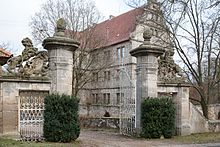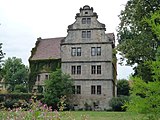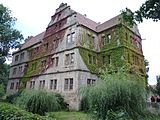Friesenhausen Castle
The Friesenhausen Castle is a moated castle in the district Friesenhausen the community Aidhausen in district Haßberge ( Lower Franconia ).
history
The castle goes back, among other things, to a Gothic castle that was surrounded by a moat. The owners of the complex, which was built in the 13th and 14th centuries, included the Lords von Heldritt , Messrs. Steinau von Steinrück and Marschalk von Ostheim , who shaped the local history for eight generations. Around 1563 a renaissance castle was built by overbuilding the old courtyard over the Gothic castle . The builders were the couple from Ostheim-Steinau von Steinrück.
In the immediate vicinity there was another Gothic castle in a lake between 1300 and 1741. This was temporarily owned by the Truchseß von Wetzhausen family , of which evidence can still be found in the Protestant church of St. Georg. The Gothic Seeburg was demolished in 1741 and the lake was filled with demolition material. The Würzburg prince-bishop Johann Gottfried von Guttenberg united the castle, which was in the Saxon fief , and the castle, which was in the fief of the Würzburg bishopric , in his possession.
The conversion to a baroque palace and other building measures were carried out under the Würzburg canon Johann Philipp Fuchs von Dornheim and the lords of Dalberg . These expanded the entire complex in 1735, among other things, with an imposing gate system with a stone bridge, equestrian figures and the family coat of arms of those of Zobel and Dalberg. The castle has elaborately designed volute gables.
After von Dalberg, who had lived in the castle since 1729 and had the Seeburg demolished in 1741, the princes of Salm-Salm lived in the castle. From 1938 it served as quarters for the Reich Labor Service ; towards the end of the war as accommodation for prisoners of war, later as a hospital for wounded German soldiers. Finally, in 1946 it became a transit camp for expellees from Silesia and the Sudetenland for one year before Caritas used it as a retirement home. From 1958 the baroque palace stood empty before it was acquired and renovated in 1973 by Wolfgang and Marianne von Eichborn . The facility is currently owned by Johann-Friedrich and Gudula von Eichborn, who were also involved in the rescue and renovation of the Johanniterburg Kühndorf near Meiningen .
At the end of the 1970s, Friesenhausen Castle was the scene of the Festival of Peace Services of groups of the West German peace movement several times at Whitsun , before it was relocated to Beienrode for reasons of space . The Protestant rural youth also used the barn, castle courtyard and park for district meetings.
- Different views of the castle
literature
- Anton Rahrbach, Jörg Schöffl, Otto Schramm: Palaces and castles in Lower Franconia - A complete representation of all palaces, manors, castles and ruins in the Lower Franconian independent cities and districts . Hofmann Verlag, Nuremberg 2002, ISBN 3-87191-309-X , pp. 46–47.
- Gudula and Johann-Friedrich von Eichborn: Friesenhausen - place and castle in the Hassberge. 2016.
Web links
- Mainpost: Schloss Friesenhausen: "Like in a house - only more beautiful!"
- Picture gallery with Friesenhausen Castle of the BR show "Under our Heaven"
Individual evidence
- ↑ Building history of Friesenhausen Castle. Retrieved January 26, 2017 .
- ↑ New book about the history of the castle. Retrieved January 26, 2017 .
- ^ Entry on Friesenhausen Castle in the private database "Alle Burgen". Retrieved January 26, 2017.
Coordinates: 50 ° 9 ′ 44.9 ″ N , 10 ° 29 ′ 15.8 ″ E





